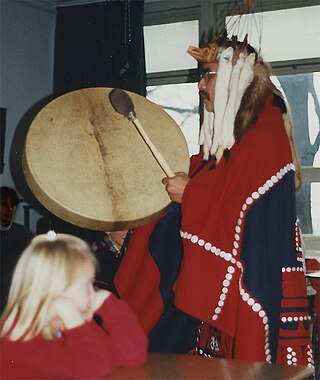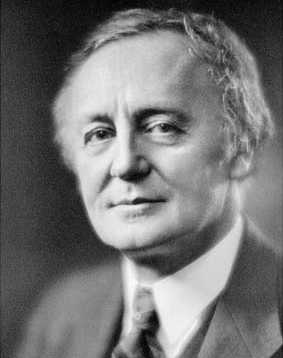
The Tsimshian are an Indigenous people of the Pacific Northwest Coast of North America. Their communities are mostly in coastal British Columbia in Terrace and Prince Rupert, and Metlakatla, Alaska on Annette Island, the only reservation in Alaska.

Klemtu is an unincorporated community on Swindle Island in the coastal fjords of British Columbia, Canada. It is located on Kitasoo Indian Reserve No. 1.

Charles Marius Barbeau,, also known as C. Marius Barbeau, or more commonly simply Marius Barbeau, was a Canadian ethnographer and folklorist who is today considered a founder of Canadian anthropology. A Rhodes Scholar, he is best known for an early championing of Québecois folk culture, and for his exhaustive cataloguing of the social organization, narrative and musical traditions, and plastic arts of the Tsimshianic-speaking peoples in British Columbia, and other Northwest Coast peoples. He developed unconventional theories about the peopling of the Americas.
The Gispwudwada or Gisbutwada is the name for the Killerwhale "clan" (phratry) in the language of the Tsimshian nation of British Columbia, Canada, and southeast Alaska. It is considered analogous or identical to the Gisgahaast clan in British Columbia's Gitxsan nation and the Gisḵ'ahaast/Gisḵ'aast Tribe of the Nisg̱a'a. The Nisg̱a'a also call this group the Killerwhale Tribe, though the Gitxsan use the term Fireweed clan; Gisgahaast means literally "people of the fireweed."
The Laxsgiik is the name for the Eagle "clan" (phratry) in the language of the Tsimshian nation of British Columbia, Canada, and southeast Alaska. It is considered analogous or identical to identically named groups among the neighboring Gitksan and Nisga'a nations and also to lineages in the Haida nation.
The Ganhada is the name for the Raven "clan" (phratry) in the language of the Tsimshian nation of British Columbia, Canada, and southeast Alaska. It is considered analogous or identical to the G̱anada (Raven/Frog) Tribe of the Nisga'a nation in British Columbia and the Frog clan among B.C.'s Gitxsan nation. The Gitxsan also sometimes use the term Laxsee'le to describe the Frog clan.
The Gitga'at are one of the 14 tribes of the Tsimshian nation in British Columbia, Canada, and inhabit the village of Hartley Bay, British Columbia, the name of which in the Tsimshian language is Txałgiu. The name Gitga'ata in the Tsimshian language means "people of the cane". The Gitga'ata, along with the Kitasoo Tsimshians at Klemtu, B.C., are often classed as "Southern Tsimshian," their traditional language being the southern dialect of the Tsimshian language. Most Tsimshian-speakers in Hartley Bay today, however, speak the form of the language shared by villages to the north. Their band government is the Hartley Bay Indian Band, aka the Gitga'at First Nation.
The Kitkatla or Gitxaala are one of the 14 bands of the Tsimshian nation of the Canadian province of British Columbia, and inhabit a village, also called Kitkatla, on Dolphin Island, a small island just by Porcher Island off the coast of northern B.C. Because of their location, the Kitkatla have sometimes been called Porcher Island Indians. They were also, in the early contact period, called the Sebassa tribe, for their paramount chief at the time, Ts'ibasaa. The name Kitkatla derives from the Tsimshian name Gitkxaała, from git- and kxaała, since they are the farthest from the mainland of the Tsimshian tribes. Another name for themselves is Git lax m'oon in recognition of the land they lived on: the islands and inlets of this rugged piece of coastline.
Kitselas, Kitsalas or Gits'ilaasü are one of the 14 tribes of the Tsimshian nation of British Columbia, in northwestern Canada. The original name Gits'ilaasü means "people of the canyon." The tribe is situated at Kitselas, British Columbia, at the upper end of Kitselas Canyon, which is on the Skeena River. It was once a great trading nexus, just outside and upriver from the city of Terrace. It is the most upriver of the 14 tribes and it borders the territory of the Gitxsan nation.
The Giluts'aaẅ are one of the 14 tribes of the Tsimshian nation in British Columbia, Canada, and one of the nine of those tribes making up the "Nine Tribes" of the lower Skeena River resident at Lax Kw'alaams, B.C. The name Giluts'aaw means literally "people of the inside". Their traditional territory is the area around Lakelse Lake, near present-day Terrace, B.C., at the Skeena River.
The Gitando are the youngest of the 14 tribes of the Tsimshian people in British Columbia, Canada. It is one of the nine of those tribes making up the "Nine Tribes" First Nation of the lower Skeena River resident at Lax Kw'alaams, British Columbia. The name Gitando means the people of weirs. Their traditional territory includes the watershed of the Exstew River, a tributary of the Skeena River. Since 1834, the Gitando have been based at Lax Kw'alaams, following establishment of a Hudson's Bay Company trading fort there. They are closely related to the Gispaxlo'ots, another of the Nine Tribes, who have an adjacent territory.
The Gits'iis are one of the 14 tribes of the Tsimshian nation in British Columbia, Canada, and one of the nine of those tribes making up the "Nine Tribes" of the lower Skeena River resident at Lax Kw'alaams, B.C.

William Beynon (1888–1958) was a Canadian hereditary chief of the Tsimshian Nation and an oral historian; he served as ethnographer, translator, and linguistic consultant to many anthropologists who studied his people.
The Laxgibuu or Laxgyibuu is the name for the Wolf "clan" (phratry) in the language of the Tsimshian nation of British Columbia, Canada, and southeast Alaska. It is considered analogous or identical to identically named clans among the neighboring Gitksan and Nisga'a nations.
Viola E. Garfield was an American anthropologist best known for her work on the social organization and plastic arts of the Tsimshian nation in British Columbia and Alaska.
Frederick Alexcee was a Canadian carver and painter from the community of Lax Kw'alaams with Tsimshian ethnicity.
Marjorie Halpin was an American-Canadian anthropologist best known for her work on Northwest Coast art and culture, especially the Tsimshian and Gitksan peoples.
John James Cove was a Canadian anthropologist known for his work with the Gitksan First Nation of northern British Columbia. He was a Professor of anthropology and sociology at Carleton University in Ottawa, Ontario, Canada.
The Wuikinuxv-Kitasoo Xai'xais-Nuxalk Tribal Council, formerly the Oweekeno-Kitasoo-Nuxalk Tribal Council, is a First Nations tribal council comprising band governments of three indigenous peoples of the Central Coast region of British Columbia, Canada. The tribal council, composed of three band governments, spans four different cultures and languages:
The Kitasoo/Xaixais First Nation, also known as the Kitasoo/Xaixais Nation, is the band government of the First Nations people of Klemtu, British Columbia, Canada. The band comprises two ethnic groups who share an ancient alliance, the Kitasoo, a Tsimshian group, and the Xai'xais, a north-wakashan speaking group. The government is a member of the Oweekeno-Kitasoo-Nuxalk Tribal Council and a member of the Tsimshian First Nations treaty council.